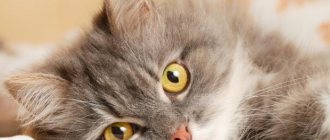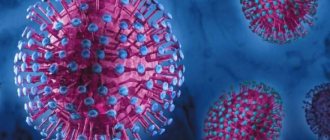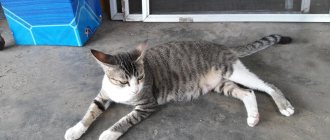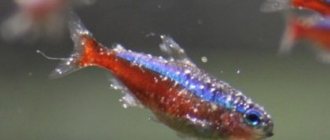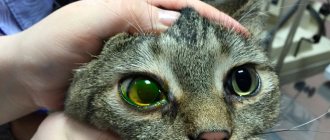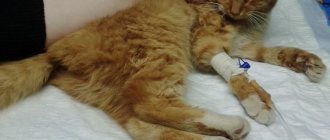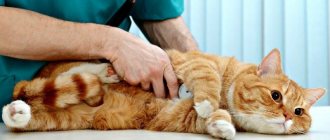Particularly dangerous is Jacobs' ulcer in cats, which is a harbinger of cancer. Pathology in most cases is observed on the lower lip, but ulcerative wounds can also form at the top and inside the mouth. The disease is rare and occurs, as a rule, in pets with weak defense mechanisms of the immune system. With pathology, a pink or red spot appears on the mucous membrane or skin, which gradually increases and affects the deeper layers. As soon as the owners notice an abscess on the cat’s upper or lower lip, they should immediately contact a veterinarian.
Description
Jacobs ulcer is characterized by the formation of a sore on the mucous membranes of the cat. Most often, the location of the pathology is the upper or lower lip of the animal. The disease has similar features to herpes labialis in humans, and affects animals with reduced immunity, as well as purebred cats.
Untimely or incorrect therapy leads to rapid progression of the disease and degeneration into fibroma or sarcoma. Another serious danger of pathology is the high risk of developing purulent inflammation in the affected mucous membranes or areas of the skin. The penetration of pathogenic microorganisms and bacteria into an open wound can cause sepsis and death of a cat.
Things to remember
When treating or diagnosing Jacobs ulcer, one must remember that this disease often manifests itself as one of the varieties of a large complex of eosinophilic granuloma.
In addition to ulcers, it can “give out”:
- Eosinophilic plaques.
- Eosinophilic granulomas.
- Allergic milliary dermatitis.
Why does the average cat owner need all this information? It just happens that all these lesions are grouped and occur in the same animal. Therefore, cases where Jacobs ulcer has spread to the abdomen are precisely a systemic complex of eosinophilic granuloma.
All diseases in this group respond to the same therapy and are diagnosed in the same way. It’s just that in case of damage to large surfaces of the body, you need to understand that something is seriously wrong with the animal’s immunity. It may be worth suspecting the presence of some kind of autoimmune disease.
Causes
The exact causes of the disease are not known. Research has shown that Jacobs ulcer has 3 main etiologies:
- Allergic, in which the ulcer is formed from granulations of eosinophils - white blood cells that protect the body from allergens. Weak animals, often suffering from allergies, are susceptible to the disease.
- Viral - an ulcer forms after a viral infection in cats with a weak immune response.
- Parasitic - it is assumed that the ulcer may appear as a result of the saliva of fleas or other ectoparasites entering the bloodstream.
European veterinarians believe that the cause of the development of Jacobs ulcer may be genetic failures. The pathology in question is more often diagnosed in purebred cats. This is due to the fact that selective breeding of the breed is often carried out through inbreeding, which leads to the occurrence of congenital genetic mutations.
There are a number of factors that increase the risk of ulcer formation. So, it is more likely to appear as a result of:
- Inappropriate living conditions, poor care of the animal.
- Poor nutrition, lack of sufficient vitamins and minerals in food.
- Bacterial and viral infectious diseases that cause a decrease in the body's defenses.
- Severe exhaustion.
- Late adoption of measures to combat fleas, lice eaters, ticks and other parasites.
- Increased susceptibility to allergies to mold, dust, medications, food.
Allergic reactions can occur to shampoos, plastic containers from which a cat eats or drinks, an insecticidal collar, etc. To understand exactly what factor caused the allergy, you need to contact an allergist who will conduct a comprehensive diagnosis of the animal.
Definition
As you know, an ulcer is a damage to the skin or mucous membrane that is difficult to heal or does not heal at all. Often such pathologies are associated with autoimmune diseases or cases where the body’s defense system practically does not function. Jacobs ulcer is one of the latter types.
The mouth and lips are affected, but in severe cases, ulcers can appear on the cheeks and spread to other parts of the body, including even the stomach. Note that the pathology is relatively rare, and therefore lesions on your pet’s lips are probably explained by a more prosaic reason. But it still wouldn’t hurt to show him to the vet.
Why is this ulcer dangerous? Firstly, constantly ulcerated areas of the skin and mucous membranes are “tidbits” for pathogenic microflora. Bactria quickly colonize these places, which is fraught with purulent inflammation and sepsis. Secondly, veterinarians have already proven for sure that Jacobs ulcer is fraught with the appearance of fibroids/sarcomas. These are extremely aggressive forms of cancer that are almost always fatal.
Symptoms
A distinctive feature of the disease is that the ulcer does not heal without treatment. At the same time, the use of medications that are inappropriate for its treatment does not help to at least reduce the symptoms.
More often the disease is found on the upper lip. Less often - on the lower part, in the mouth or on the skin of the body. Pathology can be identified by the following signs:
- At the initial stage, a small pink or red spot forms in the mucous membranes or on the skin.
- As the ulcer progresses, it increases in size and a lump forms in the affected area. The cat does not feel any discomfort, leads an active lifestyle, and does not refuse food.
- Over time, the seal takes on an irregular shape, turns into a weeping wound or becomes covered with numerous ulcerations. The wound emits an unpleasant odor.
- In advanced stages, the ulcer affects deep tissues, which leads to exposure of teeth and gums. Once these symptoms appear, the disease can no longer be treated. The ulcer causes severe discomfort and pain in the animal.
Thromboembolism
Cholecystitis
Ataxia
Sometimes the animal experiences increased salivation and the skin in the affected area turns brown.
When infected tissues become infected with bacteria, the immune system is further weakened. The animal becomes lethargic, apathetic, refuses to eat and drink, and eventually dies.
Stomach ulcers
There are two types of stomach ulcers.
- Simple gastric ulcers in cats with an irregular shape and relatively good healing
- Peptic ulcers with a round shape and thick edges.
Causes
This disease occurs quite often in cats, since there are many reasons for its occurrence.
- Various wounds, injuries and other damage to the gastric mucosa, for example, a purr may accidentally swallow a small bone or nail.
- Stress.
- Poisoning.
- Long-term feeding with cheap dry food, such as Whiskas.
- Chronic pancreatitis.
Symptoms
It is difficult not to recognize a stomach ulcer, since any cat owner will see its signs.
- Weight loss.
- Loss of appetite.
- Vomit.
- Depressed state of the animal.
Treatment methods for stomach ulcers in cats
Having diagnosed a stomach ulcer in your furry pet, the veterinarian will prescribe sedatives, painkillers and antispasmodics, as well as drugs that protect the walls of the stomach and help speed up scarring.
But treatment of this disease cannot guarantee any effect without the use of diet therapy. A recovering purr should be fed lukewarm and semi-liquid food - purees, soups and soufflés, 3-5 times a day. The veterinarian will most likely recommend one of the ready-made diets - Royal Canin, Ekanuba or Hills.
Laboratory diagnostic methods
Since in the early stages the disease does not manifest itself with any symptoms other than the formation of a barely noticeable spot, it is difficult to identify it on your own, without the help of a doctor. The owner of the animal should be wary if the animal does not experience pain when pressing on the reddish seal. If your cat is older than 8 years old, is allergic to any foods, or has recently had a viral illness, you should take her to the vet as soon as possible.
Diagnosis of the disease includes the following measures:
- A biopsy is a procedure in which the doctor examines a section of a piece of diseased tissue. If during its examination zoophilic cells are detected, then the diagnosis of Jacobs ulcer is confirmed. A biopsy also confirms or excludes the oncological nature of the ulcer.
- Blood test - helps to get an overall picture of the animal's health. Moreover, for the disease in question, this analysis does not provide any information, since the patient’s blood contains the same number of eosinophils as usual. A noticeable deviation from the norm is observed precisely in the tissues of the ulcer itself.
- Urinalysis - helps to assess the health of the animal, and is not informative in diagnosing Jacobs ulcer. During treatment, periodic examinations of the patient's urine are carried out, the results of which are compared with the data obtained from the initial urine examination. This helps to detect in time possible complications caused by intensive drug therapy.
The doctor’s task is to differentiate the pathology from an ordinary ulcer of an infectious nature, an oncological neoplasm or injury to the lip tissue.
Treatment
Successful treatment of Jacobs ulcer in cats depends on its timely detection. The earlier therapy is started, the greater the chance of defeating the disease.
During the therapeutic course, it is necessary to constantly monitor the patient's condition by conducting biochemical studies of blood and urine. Such measures are necessary to identify complications, since the medications used can lead to the development of diseases of the genitourinary system, kidneys, and diabetes.
Treatment is aimed at eliminating the provoking factor. If necessary, treatment is carried out with special preparations against fleas or other parasites, viral, fungal or bacterial infectious diseases are eliminated, and allergens are excluded.
The listed measures will help activate the body's protective functions. Special medications are also prescribed to boost immunity.
First aid
You cannot self-medicate this dangerous disease. Only an experienced veterinarian knows how to treat Jacobs ulcer in cats, what medications should be used and in what dosages. The following medications are used as medical treatment:
- Corticosteroids are hormonal agents that have an anti-inflammatory effect. Prednisolone, Dexamethasone, and Cortisone are used to treat animals. A good effect from corticosteroids is observed when they are administered intravenously.
- Immunostimulants are vitamin preparations whose action is aimed at increasing the cat’s body’s defenses. These drugs include Gamapren, Gamavit.
- Antihistamines - Suprastin, Diphenhydramine.
- Antiparasitic drugs.
Before prescribing medications, the veterinarian performs allergy tests, which prevents the development of allergies to the medications used.
Basic treatment
Medicines help only in the initial stages of the disease. Therefore, in later cases it is often necessary to resort to surgery.
Surgical intervention is required if through wounds or pronounced defects over a large area have formed in the animal’s cheeks. After surgery, it is necessary to wash the cat's mouth, lips and cheeks daily with antiseptic solutions. Such procedures are carried out until the pet recovers completely.
If the ulcer has developed into a malignant tumor that rapidly increases in size, then the disease has a poor prognosis. Removing the tumor increases the chances of survival, but relapses are common with this pathology.
Clinical manifestations
The danger of the pathology is that at the initial stage, an inattentive owner may not notice that the pet is sick. Obvious symptoms of the disease appear when the disease takes on a life-threatening nature. Stages of development of a Jacobs ulcer on a cat’s lip:
- The appearance of a small red spot on the upper lip (see photo). The animal does not experience any unpleasant sensations. It remains active and eats well. The inflamed area does not hurt or itch.
- Increased formation and appearance of a weeping wound with an unpleasant odor. The danger of this stage is that various infections can join the main pathology. The ulcer does not heal after using antiseptics, and the bacterial infection threatens the pet’s life as it quickly spreads throughout the body.
- Deepening of eczema. Gradually, the ulcer grows and affects the soft tissues. In the last stage, the wound becomes so deep and large that the gums and teeth are visible through it. The cat experiences severe pain, becomes lethargic, and refuses to eat or drink. It is very difficult to cure an animal at this stage, since the body is so weakened that it does not respond well to therapy. Most often, the pet dies from concomitant pathologies.
What are the symptoms of Jacobs' ulcer in cats that can help you determine if your cat has the disease? It's simple - a small red spot first appears on the upper lip. Note that in most cases, pathology manifests itself in this place. Situations where the primary ulcer develops on the lower lip or in the oral cavity are much rarer.
Over time, a small and almost imperceptible spot gradually turns into a huge and foul-smelling eczema. If nothing is done, then soon the signs of inflammation increase, and the unpleasant-smelling spot begins to ulcerate, deepen, and soon turns into a deep defect with dubious prospects for healing.
Let us emphasize once again that a cat with this disease behaves completely normally, does not itch, and does not show signs of pain. The appetite is normal, there are no problems with digestion or excretory function. But! All this applies only to the initial stages of the disease! If a cat’s cheek is already completely “corroded” and his teeth are sticking out, then he will have a painful reaction, and what kind of one... Here secondary infections and a general weakening of the body make their contribution. The animal gradually loses its appetite and becomes lethargic.
Prevention
One of the main preventive measures is to pay attention to your pet and immediately contact a veterinarian if suspicious symptoms are detected.
Prevention and control measures against fleas, ticks and other parasites should not be neglected. To avoid the development of allergic reactions to food, feed your animal only special hypoallergenic food. Include in your diet all the vitamins and minerals necessary for it.
Animals over 8 years of age should be regularly examined for ulcers, seal wounds and other defects.
Factors influencing pathology
The main predisposing factor to the development of pathology is low immunity. A weakened animal gets sick more often, which causes an autoimmune reaction, expressed in the formation of eosinophilic granulomas. The following factors lead to a decrease in the cat’s body’s defenses:
- Failure to comply with nutritional rules. The cat's diet should contain proteins, fats, carbohydrates, vitamins and microelements. Some owners prefer to save on their cat's nutrition by offering it food from their table. However, this menu does not provide the animal’s body with all the elements necessary for normal development. Particular attention should be paid to the diet of cats with special needs (neutered, with chronic pathologies, aging).
- Improper care and poor living conditions. Cats of different breeds require different care. Some people should regularly treat their eyes to prevent inflammatory processes, while others are prone to ear pathologies, so you need to constantly monitor the condition of your ears.
- Feeding poor quality food. For purebred cats, you should choose premium and super-premium food. Economy options often contain a large number of preservatives, dyes and flavors that can accumulate in the body and provoke pathological processes.
- Using household chemicals to wash your pet's tray and dishes. Some chemicals can cause allergies. If it is not possible to eliminate dirt and unpleasant odors without special means, you should thoroughly rinse the objects that the animal comes into contact with.
- Past viral and bacterial diseases. After illness, the pet’s body becomes vulnerable to many pathologies.
- No treatment for parasites. To prevent your cat from suffering from fleas and ticks, you should regularly treat its fur with special products. In the warm season, after a walk outside, you need to inspect your cat’s skin for ticks.
- Failure to comply with the schedule of preventive vaccinations.
- Frequent manifestations of allergies. If your cat exhibits allergic symptoms several times a year, you should find out what is causing them. If there is a provoking factor, the cat’s condition will worsen and a Jacobs ulcer will appear.
A single Jacob's sore or multiple pink spots on a cat's lips may be the result of an allergic reaction. The components of the ulcer are eosinophilic granulations - white blood cells responsible for autoimmune processes in the pet’s body. With allergies, their number increases, which leads to the formation of sores on the cat’s lips. Irritation and allergic reactions can occur under the influence of such irritants:
- dust present in the house and on the street;
- plant pollen;
- feed components;
- medications;
- mold;
- microscopic fungi.
